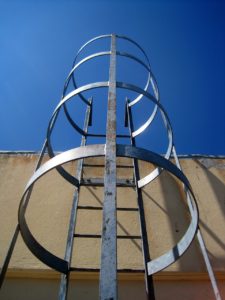Ladder Incident Offshore
There were recent reports of an incident on board an offshore vessel in Newfoundland. A worker was injured after falling from a ladder while conducting gas testing. As a result of this incident, the Canada-Newfoundland and Labrador Offshore Petroleum Board (C-NLOPB) ordered the operator to ensure that a fall protection system is in place for all vertical ladders greater than six (6) meters (that are not fitted with a protective cage).
We figured this would be an appropriate time to provide a general review and detail of the fall protection requirements and options for fixed ladders.
Fall Protection Requirements for Fixed Ladders
For offshore work in Newfoundland and Labrador, as per the Canada – Newfoundland and Labrador Offshore Marine Installations and Structures Occupational Health and Safety Transitional Regulations, a fall protection system is required for all vertical ladders greater than six meters (19.7 ft). This does not include ladder cage requirements.
For work in Newfoundland and Labrador, as per the Newfoundland and Labrador Occupational Health and Safety Regulations, an acceptable device to prevent workers from falling (fall protection system) is required for all fixed ladders greater than 7.32 meters (24 ft). This does not include ladder cage requirements.
Ladder Cages are a Thing of the Past

For many years, fixed ladders have been fabricated with ladder cages or “safety cages”. The original intent of these ladder cages was to provide a form of fall protection for the user.
However, research into the effectiveness of ladder cages has shown that they do not provide appropriate fall protection. In addition, ladder cages are considered hazardous as a worker’s limbs can often get caught in them during a fall – causing severe injury to the worker.
As a result, effective November 19th , 2018, the industry-leading United States Department of Labor Occupational Safety and Health Administration (OHSA) eliminated fixed ladder cages as a form of fall protection.
It is only a matter of time until the Newfoundland and Labrador regulations are updated to reflect this change.
Properly Fall Protecting a Ladder
 Our firm does not support, recommend, design or certify ladder cages as a form of proper fall protection. As we described above, a ladder cage does not provide appropriate fall protection.
Our firm does not support, recommend, design or certify ladder cages as a form of proper fall protection. As we described above, a ladder cage does not provide appropriate fall protection.
We recommend proper ladder climbing systems such as wire rope ladder climbing systems.
With an appropriate wire rope ladder climbing system, the user’s free-fall distance is greatly reduced. In addition, the user is connected to their front d-ring (on harness). This will ensure that they do not spin/swing.
The typical incidents on ladders are slips and falls. With a wire rope ladder climbing system, the user will be immediately arrested, and in most cases, can continue their climb. With a ladder cage, however, this fall will not be prevented – therefore creating the possibility of severe injury, fatality and workplace stoppage.
Selecting and implementing the right solution is essential for both worker safety and workplace efficiency. For further information on selecting this solution, contact our Fall Protection Specialists.
Secure2 Engineering is an engineering firm specializing in fall protection and work at height. Secure2 provides a wide variety of fall protection services including consulting, design, supply, installation, testing and certification. Feel free to contact a Fall Protection Specialist for more information.
